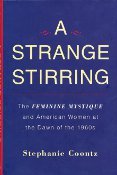When feminist leader Betty Friedan passed away in February 2006, traditional and online media were flooded with stories from women who were affected in some way by her 1963 book, "The Feminine Mystique." Scholarly eulogies attempted to explain or contextualize the book's significance to the American feminist movement. My favorite assessment came from the feminist blogger Echidne of the Snakes, who emphasized Friedan's role as "name-giver."
"Because so many women identified with what she described," Echidne wrote at the time, "... it was possible to discuss this condition, and that was the first stage of doing something about it."
Friedan was not the first to confront what she called "the problem that has no name," but she was the first to describe it in a way that stuck.
I think Friedan's most impressive accomplishment in "The Feminine Mystique" was not that she proved middle-class housewives were unhappy with the status quo; they already knew that, or they wouldn't have had any reason to read the book in the first place. It was that she addressed them as human beings whose unhappiness mattered (a radical idea at a time when womanhood was linked to self-sacrifice), to identify the situation that sexism had created, and to hint at possible avenues for solutions that Friedan would herself help to actualize by taking on a strong, long-term leadership role in the women's movement. Her book provided a common vocabulary for people new to the women's movement by introducing middle-class suburbia and radical sociology to each other, becoming a bestseller at an unlikely time and by appealing to an unlikely audience.
Stephanie Coontz's "A Strange Stirring: The Feminine Mystique and American Women at the Dawn of the 1960s" (Basic Books, 2011 $25.95) attempts to explain exactly how Friedan pulled all of this off, and what it meant to American feminism when she did. She does this partly by providing a substantial, original, and badly-needed critical biography of "The Feminine Mystique," and partly by simply telling the story of Friedan as her readers saw her—describing how the book affected their lives by simultaneously validating and challenging their perception of the world. What Coontz discovers is that Friedan was not always as groundbreaking, comprehensive or radical as she might have appeared at the time, and occasionally she lied outright about her own history or the circumstances under which the book was published. But Friedan's skill as a writer and her uncanny ability to connect with her audience, made her essential to the story of American second-wave feminism.
It is impossible to read this book and come away with the impression that Betty Friedan was a saint, but the book does make it clear that she was a warrior—and her courage, persistence, and talent made her an especially deadly adversary to the paternalistic, pseudo-scientific sexism of post-World War II middle-class suburban America. Friedan's greatest accomplishment may have been that she provided a mirror to concerns that women living under this tyranny already felt, amplifying their voices and helping them organize to address these concerns collectively.
"It in no way disparages Friedan's accomplishments to point out that 'The Feminine Mystique' was not ahead of its time," Coontz writes. "Books don't become best sellers because they're ahead of their time."
"A Strange Stirring" is readable, breezy and entertaining. You'll finish it in one or two sittings without great difficulty, and it is not necessary to read "The Feminine Mystique" to understand the story Coontz tells. The strongest chapter in the book is probably the first, "The Unliberated '60s," which explains what Friedan and her contemporaries faced by describing a legal and political system that sounds as terrifyingly dystopian as that of Iran or Saudi Arabia. Even readers who have no interest in "The Feminine Mystique" would be well served to pick up a copy of "A Strange Stirring" long enough to read its first 18-page chapter and marvel at how much the feminist movement has accomplished in 50 years, partly as the result of Friedan's hard work.
But the weakest element of the book is its gentleness toward men, and especially men of Friedan's generation. I'm not suggesting that it's necessary to vilify men to explain the history of sexism, but it is necessary to confront institutional manhood—to acknowledge that the people with the money, social prestige and political power to enforce the old system of gender apartheid were indeed men, which made changing this system an extraordinarily difficult task (as the defeat of the Equal Rights Amendment demonstrated). Coontz describes the challenge of the "Feminine Mystique"-generation as if it were an internal struggle among women to find their voices, but making these voices heard over the objections of self-serving men and their allies remains a challenge.
Freelance writer Tom Head is a lifelong Jacksonian. He has authored or co-authored 24 nonfiction books on a wide range of topics, is a civil liberties writer for About.com, and volunteers as a grassroots progressive activist.



Comments
Use the comment form below to begin a discussion about this content.
comments powered by Disqus